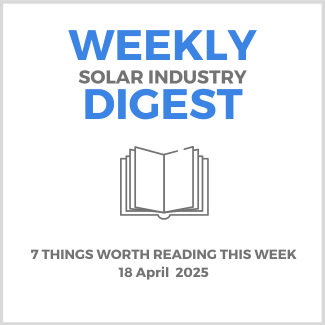Terrasmart’s Solar Instant Feasibility Tool (SIFT) does topographical site assessment to speed up site selection. SIFT helps developers and EPCs with system design, performance, and financial modeling early in the project cycle – it IDs best racking system and optimizes layouts. It has been applied to 250 GWs of potential capacity with asset owners reporting 5% to 15% higher returns on their projects.
SPW looks at how AI predictive solar maintenance is more effective than reactive maintenance via scheduled inspections and repairs to avoid problems. AI means a better way of predicting those problems and can improve energy output, reduce downtime and cut costs. Unplanned system downtime costs manufacturers around $50 billion annually while AI assisted predictive maintenance can increase productivity by 25%, reduce breakdowns by 70% and lower maintenance costs by 25%. Apparently 77% of surveyed companies plan to transition to predictive maintenance, with AI being the key enabler of this.
U.S. solar capacity will double in four years to 182 GW in 2026, according to the EIA. They predict that solar will increase by 35% in 2025 and by 18% in 2026. They also expect higher power prices and a modest upswell in demand.
CA public entities like schools, local government buildings, and public water treatment plants only have until April 2026 to install/interconnect projects to get the more lucrative rates set by NEM 2.0, as opposed to those of NEM 3.0. Rates moved from an average of $.30 per kWh under 2.0 to about $.07 per kW for PG&E, Southern CA Edison and SDG&E customers under NEM 3.0.
Four members of Congress penned a letter to the Senate Majority Leader asking to protect the IRA, in addition to the 3/9 letter to the Chairman of the House Committee on Ways and Means signed by 21 Republican representatives. This letter was from Senators Lisa Murkowski (R-AK), Thom Tillis (R-FL), John Curtis (R-UT) and Jerry Moran (R-KS).
In this Solar Conversation, Kerim Baran of SolarAcademy sits down with Jim Wood, CEO of SEG Solar, to discuss how the company has carved a unique position in the solar panel manufacturing industry. SEG Solar is a bootstrapped, American-owned solar panel company with operations in the U.S. and Asia, balancing cost-effective manufacturing with a commitment to domestic production. Jim shares insights into SEG Solar’s growth strategy, competitive advantages, and future vision, including the challenges and opportunities in the evolving policy and market landscape. The topics discussed included the following among others:
- The origins and growth of SEG Solar as a bootstrapped company.
- How SEG balances U.S.-based and international manufacturing to stay competitive.
- The impact of changing tariffs and policy on the solar panel industry.
This video looks to demystify the complexity of commercial-scale VPPs by spotlighting how two companies are tapping it. Molecule Systems and Enersponse execs explain how to integrate commercial DERs into VPP programs and how this can help DERs unlock new revenue streams and energy cost savings. The video is below.

